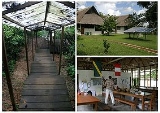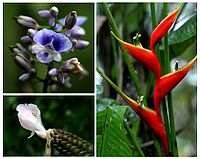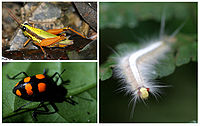
Los Amigos Biological Station
Encyclopedia
The Los Amigos Biological Station is a research station in lowland Amazonian forest at the base of Peru
's southern Andes
, at 270 masl in Madre de Dios department. The station's official name in Spanish is Centro de Investigación y Capacitación Río Los Amigos (Los Amigos Research and Training Center). It is commonly known by its Spanish acronym, CICRA.
 The station sits on a high terrace at the confluence of the Madre de Dios and Los Amigos rivers. CICRA's small private property is contiguous to the Los Amigos Conservation Concession (LACC), which protects a diversity of upland and lowland forest types and aquatic habitats in 1,450 km² of the lower Los Amigos watershed
The station sits on a high terrace at the confluence of the Madre de Dios and Los Amigos rivers. CICRA's small private property is contiguous to the Los Amigos Conservation Concession (LACC), which protects a diversity of upland and lowland forest types and aquatic habitats in 1,450 km² of the lower Los Amigos watershed
. Population density in a 5 km radius of the station is approximately 2 persons per square kilometer, mostly itinerant gold miners working concessions along the Madre de Dios River; the 30-person village of Boca Amigos is 2 km from the station. Within the LACC, population density
is zero, with the exception of occasional visits by uncontacted indigenous
groups.
Research
and training facilities at CICRA include lodging for 50 visitors, 250 m2 of laboratory space, a lecture hall, a >50-km trail system, a 60-m radio tower, satellite internet access, access to online scientific literature and databases, high-resolution digital aerial photos of >200,000 ha of surrounding forests, a digital flora of >2,500 plant species collected on-site, a 470-volume scientific library, a weather station dating to 2000, and field guides to fish
, amphibians and reptiles, and plants. Off-site resources include two smaller satellite stations, each with their own laboratories and lodging, 3 and 25 km from the main station; a GIS laboratory in nearby Puerto Maldonado
; and two additional 60-m radio towers inside the conservation concession.
 The station was established in 2000 by two non-governmental organizations: the Peruvian NGO Asociación para la Conservación de la Cuenca Amazónica (ACCA) and the US-based Amazon Conservation Association
The station was established in 2000 by two non-governmental organizations: the Peruvian NGO Asociación para la Conservación de la Cuenca Amazónica (ACCA) and the US-based Amazon Conservation Association
(ACA). The station is administered by ACCA, in partnership with ACA and a third NGO, the Amazon Center for Environmental Education and Research (ACEER). The long-term vision of these groups is to make CICRA the leading field destination for researchers and students in Amazonia.
In 2005-2009, CICRA was the most active research station in the Amazon basin
, hosting an average of 24 researchers and assistants per day. During the same period, it was likely also the most intensively studied site in the Amazon, hosting 145 different research projects spanning animal behavior, biogeochemistry
, botany
, conservation biology, geology
, hydrology
, zoology
, as well as biological inventories of 31 different taxa, ranging from copepods to marsupials. These numbers place CICRA behind Panama
's Barro Colorado Island and Costa Rica
's La Selva Biological Station -- the leading Neotropical research stations -- but ahead of other field stations in the Amazon basin. Most research visitors are associated with universities in Peru or abroad, and many receive funding to visit the station through ACA and ACCA's grant programs.
Los Amigos is also a leading training site for young Amazonian scientists and conservationists. From 2002 to 2009 the station hosted 19 field courses, ranging from introductory courses on Amazonia to specialized courses on plant identification, ornithology
, and arthropod biology. More than 70% of the >300 students who participated in these courses were Latin American.
Through 2006, the station received the majority of its funding from the Gordon and Betty Moore Foundation
. Additional funds have come from ACEER, the Botanical Research Institute of Texas, the National Geographic Society
, the U.S. National Science Foundation, and private donors. Since mid-2005, the station has covered its operating expenses with station fees from visiting researchers and courses.
For information in Spanish, check out the CICRA page on Wikipedia en español!
(http://es.wikipedia.org/wiki/CICRA).
Peru
Peru , officially the Republic of Peru , is a country in western South America. It is bordered on the north by Ecuador and Colombia, on the east by Brazil, on the southeast by Bolivia, on the south by Chile, and on the west by the Pacific Ocean....
's southern Andes
Andes
The Andes is the world's longest continental mountain range. It is a continual range of highlands along the western coast of South America. This range is about long, about to wide , and of an average height of about .Along its length, the Andes is split into several ranges, which are separated...
, at 270 masl in Madre de Dios department. The station's official name in Spanish is Centro de Investigación y Capacitación Río Los Amigos (Los Amigos Research and Training Center). It is commonly known by its Spanish acronym, CICRA.

Drainage basin
A drainage basin is an extent or an area of land where surface water from rain and melting snow or ice converges to a single point, usually the exit of the basin, where the waters join another waterbody, such as a river, lake, reservoir, estuary, wetland, sea, or ocean...
. Population density in a 5 km radius of the station is approximately 2 persons per square kilometer, mostly itinerant gold miners working concessions along the Madre de Dios River; the 30-person village of Boca Amigos is 2 km from the station. Within the LACC, population density
Population density
Population density is a measurement of population per unit area or unit volume. It is frequently applied to living organisms, and particularly to humans...
is zero, with the exception of occasional visits by uncontacted indigenous
Indigenous peoples
Indigenous peoples are ethnic groups that are defined as indigenous according to one of the various definitions of the term, there is no universally accepted definition but most of which carry connotations of being the "original inhabitants" of a territory....
groups.
Research
Research
Research can be defined as the scientific search for knowledge, or as any systematic investigation, to establish novel facts, solve new or existing problems, prove new ideas, or develop new theories, usually using a scientific method...
and training facilities at CICRA include lodging for 50 visitors, 250 m2 of laboratory space, a lecture hall, a >50-km trail system, a 60-m radio tower, satellite internet access, access to online scientific literature and databases, high-resolution digital aerial photos of >200,000 ha of surrounding forests, a digital flora of >2,500 plant species collected on-site, a 470-volume scientific library, a weather station dating to 2000, and field guides to fish
Fish
Fish are a paraphyletic group of organisms that consist of all gill-bearing aquatic vertebrate animals that lack limbs with digits. Included in this definition are the living hagfish, lampreys, and cartilaginous and bony fish, as well as various extinct related groups...
, amphibians and reptiles, and plants. Off-site resources include two smaller satellite stations, each with their own laboratories and lodging, 3 and 25 km from the main station; a GIS laboratory in nearby Puerto Maldonado
Puerto Maldonado
Puerto Maldonado is a city in Southeastern Peru in the Amazon forest west of the Bolivian border on the confluence of the Tambopata and Madre de Dios River, a tributary of the Amazon River. It is the capital of the Madre de Dios Region....
; and two additional 60-m radio towers inside the conservation concession.

Amazon Conservation Association
Amazon Conservation Association is a 5013 non-profit organization working to conserve the biodiversity of the Amazon Basin through the development of new scientific understanding, sustainable resource management and rational land-use policy....
(ACA). The station is administered by ACCA, in partnership with ACA and a third NGO, the Amazon Center for Environmental Education and Research (ACEER). The long-term vision of these groups is to make CICRA the leading field destination for researchers and students in Amazonia.
In 2005-2009, CICRA was the most active research station in the Amazon basin
Amazon Basin
The Amazon Basin is the part of South America drained by the Amazon River and its tributaries that drains an area of about , or roughly 40 percent of South America. The basin is located in the countries of Bolivia, Brazil, Colombia, Ecuador, Guyana, Peru, and Venezuela...
, hosting an average of 24 researchers and assistants per day. During the same period, it was likely also the most intensively studied site in the Amazon, hosting 145 different research projects spanning animal behavior, biogeochemistry
Biogeochemistry
Biogeochemistry is the scientific discipline that involves the study of the chemical, physical, geological, and biological processes and reactions that govern the composition of the natural environment...
, botany
Botany
Botany, plant science, or plant biology is a branch of biology that involves the scientific study of plant life. Traditionally, botany also included the study of fungi, algae and viruses...
, conservation biology, geology
Geology
Geology is the science comprising the study of solid Earth, the rocks of which it is composed, and the processes by which it evolves. Geology gives insight into the history of the Earth, as it provides the primary evidence for plate tectonics, the evolutionary history of life, and past climates...
, hydrology
Hydrology
Hydrology is the study of the movement, distribution, and quality of water on Earth and other planets, including the hydrologic cycle, water resources and environmental watershed sustainability...
, zoology
Zoology
Zoology |zoölogy]]), is the branch of biology that relates to the animal kingdom, including the structure, embryology, evolution, classification, habits, and distribution of all animals, both living and extinct...
, as well as biological inventories of 31 different taxa, ranging from copepods to marsupials. These numbers place CICRA behind Panama
Panama
Panama , officially the Republic of Panama , is the southernmost country of Central America. Situated on the isthmus connecting North and South America, it is bordered by Costa Rica to the northwest, Colombia to the southeast, the Caribbean Sea to the north and the Pacific Ocean to the south. The...
's Barro Colorado Island and Costa Rica
Costa Rica
Costa Rica , officially the Republic of Costa Rica is a multilingual, multiethnic and multicultural country in Central America, bordered by Nicaragua to the north, Panama to the southeast, the Pacific Ocean to the west and the Caribbean Sea to the east....
's La Selva Biological Station -- the leading Neotropical research stations -- but ahead of other field stations in the Amazon basin. Most research visitors are associated with universities in Peru or abroad, and many receive funding to visit the station through ACA and ACCA's grant programs.
Los Amigos is also a leading training site for young Amazonian scientists and conservationists. From 2002 to 2009 the station hosted 19 field courses, ranging from introductory courses on Amazonia to specialized courses on plant identification, ornithology
Ornithology
Ornithology is a branch of zoology that concerns the study of birds. Several aspects of ornithology differ from related disciplines, due partly to the high visibility and the aesthetic appeal of birds...
, and arthropod biology. More than 70% of the >300 students who participated in these courses were Latin American.
Through 2006, the station received the majority of its funding from the Gordon and Betty Moore Foundation
Gordon and Betty Moore Foundation
Gordon and Betty Moore Foundation seeks to develop outcome-based projects that will improve the quality of life for future generations. The private foundation focuses upon portfolios of large-scale initiatives and encourages collaboration so as to achieve the most significant and enduring outcomes...
. Additional funds have come from ACEER, the Botanical Research Institute of Texas, the National Geographic Society
National Geographic Society
The National Geographic Society , headquartered in Washington, D.C. in the United States, is one of the largest non-profit scientific and educational institutions in the world. Its interests include geography, archaeology and natural science, the promotion of environmental and historical...
, the U.S. National Science Foundation, and private donors. Since mid-2005, the station has covered its operating expenses with station fees from visiting researchers and courses.
For information in Spanish, check out the CICRA page on Wikipedia en español!
(http://es.wikipedia.org/wiki/CICRA).
External links
- ACA's page on Los Amigos/CICRA
- CICRA homepage
- http://www.telegraph.co.uk/expat/expatlife/7429086/My-scatological-jungle-adventure.html - Telegraph newspaper article on CICRA

